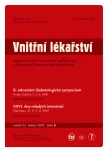Defining the level of physical activity for a diabetic who is obese
Authors:
M. Matoulek
Authors‘ workplace:
III. interní klinika 1. lékařské fakulty UK a VFN Praha, přednosta prof. MUDr. Štěpán Svačina, DrSc., MBA
Published in:
Vnitř Lék 2007; 53(5): 560-562
Category:
Overview
Physical activity plays an important role in the treatment of metabolic syndrome and/or type 2 diabetes or obesity. Less than 20 % of the adult population does physical exercise at least twice a week. The effectiveness of physical exercise depends on paying attention to the following parameters: the frequency, the intensity and the duration. The most difficult parameter to set for patients with obesity or metabolic syndrome is the optimum intensity of exercise. The most common means of measuring the intensity of physical activity is heart rate or pulse rate. With patients who take medicines that affect their heart rate, the Borg scale is used to give a subjective rating of perceived exertion. To set optimal intensity it is necessary to use exertion tests with these patients. The most accurate setting is a suitable combination of spiroergometry and a CHR (clamped heart rate) test. In practice, though, it is usually enough to combine ergometry together with the Borg scale. Tracking exertion parameters during exercise improves patient compliance and also the results of exercise.
Key words:
obesity – type 2 diabetes mellitus – metabolic syndrome – physical activity – spiroergometry – CHR test
Sources
1. Boulé NG, Haddad E, Kenny GP et al. Effects of exercise on glycemic control and body mass in type 2 diabetes: meta-analysis of controlled clinical trials. JAMA 2001; 286: 1218-1227.
2. Kraus WE, Houmard JA, Duscha KD et al. Effects of the amounted intensity of exercises on plasma lipoproteins. N Engl J Med 2002; 347: 1283-1292.
3. Lee S, Kuk JL, Davidson LE et al. Exercise without weight los sis an effective strategy in obese individuals with and without type 2 diabetes. J Appl Physiol 2005; 99: 1220-1225.
4. Paffenbarger RS Jr, Hyde RT, Wing N et al. The association of changes in physical-activity level and other lifestyle characteristic with mortality in men. N Engl J Med 1993; 328: 538-545.
5. Tanasescu M, Leitzmann MF, Rimm EB et al. Exercise type and intensity in realtion to coronary disease in men. JAMA 2002; 288: 2000-2004.
Labels
Diabetology Endocrinology Internal medicineArticle was published in
Internal Medicine

2007 Issue 5
Most read in this issue
- Inflammatory diseases of the eye
- Tinnitus and diabetes
- Increased activity of the sympathetic nervous system and the possibilities for therapeutic influence
- Olfaction and gustation in diabetes
